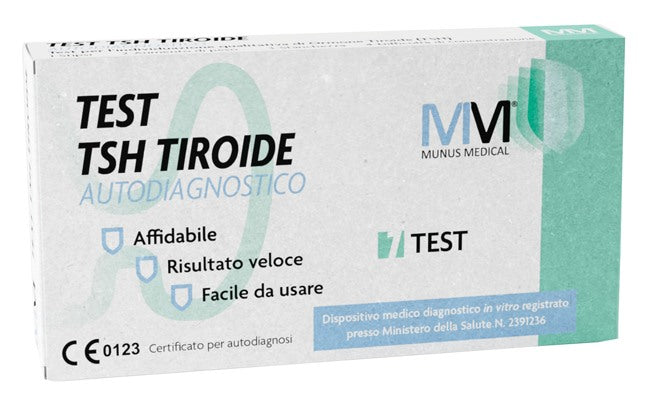MUNUS MEDICAL SELF-DIAGNOSTIC TSH THYROID TSH MUNUS
Sold out
€9,90
Unit price
/
Unavailable
Tax included, shipping and discounts calculated at checkout.
MUNUS INTERNATIONAL | SKU:
986885174
Notify me when it's back in stock!
Write us your email, you will be notified when this product becomes available again!
MUNUS MEDICAL SELF-DIAGNOSTIC TSH THYROID TSH MUNUS is backordered and will ship as soon as it is back in stock.
Shipping Costs and Times
Shipping Costs and Times
- Order fulfillment within 24 hours and delivery within the following 48/72 hours.
- Shipping cost: always free for orders over €49.90, otherwise it costs €4.99.
Payments
Payments
Payment information is processed securely. We do not store credit card information or have access to your credit card information.
Returns and Refunds
Returns and Refunds
You can return and receive a refund for the item within 30 days. See full policy here.

Do you need help?
Our customer service is here to help you!
- Contact us by phone, email or WhatsApp, from Monday to Friday, from 9:00 to 20:00 .
- For common questions, such as tracking your order or checking its fulfillment status, you can count on our artificial intelligence , available 24/7 .
We are always at your side to offer you fast and effective support!
Description
Description
MUNUS MEDICAL SELF-DIAGNOSTIC TSH THYROID TSH MUNUS
MUNUS MEDICAL
THYROID TSH TEST
Description
Rapid chromatographic immunoassay for the qualitative detection of TSH in human whole blood at a cut-off concentration of 5 mcIU/mL.
The Thyroid TSH Test is a qualitative, membrane-based immunoassay for the detection of thyroid stimulating hormone (TSH) in whole blood specimens. In this test procedure, anti-TSH antibody is immobilized in the test area and coated particles. After the sample is added to the sample well of the cassette, it reacts with the anti-TSH antibody-coated particles in the test. The mixture migrates chromatographically along the test and interacts with the immobilized anti-TSH antibody.
Positive samples react with the specific anti-TSH antibody-coated particles to form a colored line in the test region of the membrane.
The absence of the colored line suggests a negative result.
For procedural control purposes, a colored line will always appear in the control region to indicate that an adequate volume of sample has been added and capillary penetration into the membrane has occurred.
This test provides a preliminary diagnostic result and can be used for TSH screening.
How to use
Wash hands with soap and rinse with warm water.
Bring the bag to room temperature before opening. Open the foil bag and remove the cassette.
Carefully remove and discard the lancet cap. Use the alcohol swab provided to clean the tip of your middle or ring finger as the puncture site. Press the lancet, on the side from which the cap was removed, against the tip of your finger (the ring finger is recommended). The tip automatically and safely retracts after use.
Keeping your hand down, massage the end that has been pricked to obtain a drop of blood. Place the capillary dropper bulb in contact with the blood, without squeezing the bulb. The blood will migrate into the capillary dropper to the indicated line. If the line is not reached, you can massage your finger again to obtain more blood. Avoid air bubbles. Pour the collected blood into the cassette sampling well, squeezing the dropper bulb. Wait until the blood has completely dispensed into the well. Unscrew the cap of the buffer bottle and add 2 drops of buffer to the cassette sampling well.
Wait for the colored lines to appear. Read the result at 10 minutes. Do not interpret the result after 20 minutes.
Reading the results
POSITIVE: Two colored lines appear. Both the T (test) and C (control) lines appear.
This result means that the TSH level is higher than normal (5 mcIU/mL) and that it is necessary to consult a doctor.
NEGATIVE: One colored line appears. Only the control line (C) appears.
This result means that the TSH level is not within the range of values that determine hypothyroidism.
INVALID: The control line is not displayed. The most likely reasons for the control line not being displayed are insufficient sample volume or incorrect procedural techniques. Review the procedure and retest with a new test. If the problem persists, discontinue use of the test kit immediately and contact your local distributor.
Warnings
Please read all the information in this leaflet before performing the test.
For in vitro self-diagnostic use only.
Do not eat, drink, or smoke in the area where specimens or kits are handled.
If the foil package is damaged or has been opened, do not use.
This test kit should be used only as a preliminary test and repeatedly abnormal results should be discussed with your doctor or clinical professional.
Strictly adhere to the indicated timeframes.
Use the test only once. Do not disassemble and touch the test window of the cassette.
The kit must not be frozen or used after the expiration date printed on the package.
Keep out of reach of children.
The used test must be disposed of according to local regulations.
The test is intended for the detection of TSH in whole blood samples only. This qualitative test does not allow the quantitative value or rate of increase of TSH concentration to be determined.
The rapid test is only intended for screening for primary hypothyroidism in the adult population, not in newborns.
As with all diagnostic tests, all results should be interpreted in conjunction with other clinical information available to the physician.
A positive test should be confirmed using a quantitative laboratory test for TSH.
False positive results may occur due to heterophilic (unusual) antibodies. In some clinical conditions such as central hypothyroidism, TSH levels may be normal/low despite hypothyroidism. Medical consultation is recommended to evaluate such cases.
For central/secondary hypothyroidism, TSH is not a reliable biomarker, this occurs in 1 in 1,000 cases of hypothyroidism.
Conservation
Store in a dry place at 2-30°C (36-86°F), avoiding areas of excessive humidity. Do not freeze.
The test is stable until the expiration date printed on the sealed pouch. The test must remain in the sealed pouch until use. Do not use beyond the expiration date.
Validity with intact packaging: 24 months.
Format
The kit contains:
- test cassette;
- capillary dropper;
- buffer;
- alcohol swab;
- hand;
- package leaflet.
Bibliography
1. Merck Manual of Diagnosis and Therapy, Thyroid gland disorders.
2. The American Heritage Dictionary of the English Language, Fourth Edition. Houghton Mifflin Company. 2006. ISBN 0-395-82517-2.
3. Sacher R, Richard A. McPherson (2000). Widmann's Clinical Interpretation of Laboratory Tests, 11th ed. F. A. Davis Company. ISBN 0-8036-0270-7.
4. So, M; MacIsaac, R.J.; Grossmann M (August 2012). "Hypothyroidism". Australian Family Physician 41(8): 556–62.
5. Surkset. al.,JAMA 291:228, 2004. Daniel,GH, Martin, JB, Neuroendocrine Regulation and Diseases of the Anterior Pituitary and Hypothalamus in Wilson, JD, Braunwald, E., Isselbacher, KJ, et. al., Harrison's Principles of Internal Medicine, 12th Edition, McGraw-Hill, Inc., New York, NY, 1991, p. 1666).
Cod. MM-OTS-402H
Rapid chromatographic immunoassay for the qualitative detection of TSH in human whole blood at a cut-off concentration of 5 mcIU/mL.
The Thyroid TSH Test is a qualitative, membrane-based immunoassay for the detection of thyroid stimulating hormone (TSH) in whole blood specimens. In this test procedure, anti-TSH antibody is immobilized in the test area and coated particles. After the sample is added to the sample well of the cassette, it reacts with the anti-TSH antibody-coated particles in the test. The mixture migrates chromatographically along the test and interacts with the immobilized anti-TSH antibody.
Positive samples react with the specific anti-TSH antibody-coated particles to form a colored line in the test region of the membrane.
The absence of the colored line suggests a negative result.
For procedural control purposes, a colored line will always appear in the control region to indicate that an adequate volume of sample has been added and capillary penetration into the membrane has occurred.
This test provides a preliminary diagnostic result and can be used for TSH screening.
How to use
Wash hands with soap and rinse with warm water.
Bring the bag to room temperature before opening. Open the foil bag and remove the cassette.
Carefully remove and discard the lancet cap. Use the alcohol swab provided to clean the tip of your middle or ring finger as the puncture site. Press the lancet, on the side from which the cap was removed, against the tip of your finger (the ring finger is recommended). The tip automatically and safely retracts after use.
Keeping your hand down, massage the end that has been pricked to obtain a drop of blood. Place the capillary dropper bulb in contact with the blood, without squeezing the bulb. The blood will migrate into the capillary dropper to the indicated line. If the line is not reached, you can massage your finger again to obtain more blood. Avoid air bubbles. Pour the collected blood into the cassette sampling well, squeezing the dropper bulb. Wait until the blood has completely dispensed into the well. Unscrew the cap of the buffer bottle and add 2 drops of buffer to the cassette sampling well.
Wait for the colored lines to appear. Read the result at 10 minutes. Do not interpret the result after 20 minutes.
Reading the results
POSITIVE: Two colored lines appear. Both the T (test) and C (control) lines appear.
This result means that the TSH level is higher than normal (5 mcIU/mL) and that it is necessary to consult a doctor.
NEGATIVE: One colored line appears. Only the control line (C) appears.
This result means that the TSH level is not within the range of values that determine hypothyroidism.
INVALID: The control line is not displayed. The most likely reasons for the control line not being displayed are insufficient sample volume or incorrect procedural techniques. Review the procedure and retest with a new test. If the problem persists, discontinue use of the test kit immediately and contact your local distributor.
Warnings
Please read all the information in this leaflet before performing the test.
For in vitro self-diagnostic use only.
Do not eat, drink, or smoke in the area where specimens or kits are handled.
If the foil package is damaged or has been opened, do not use.
This test kit should be used only as a preliminary test and repeatedly abnormal results should be discussed with your doctor or clinical professional.
Strictly adhere to the indicated timeframes.
Use the test only once. Do not disassemble and touch the test window of the cassette.
The kit must not be frozen or used after the expiration date printed on the package.
Keep out of reach of children.
The used test must be disposed of according to local regulations.
The test is intended for the detection of TSH in whole blood samples only. This qualitative test does not allow the quantitative value or rate of increase of TSH concentration to be determined.
The rapid test is only intended for screening for primary hypothyroidism in the adult population, not in newborns.
As with all diagnostic tests, all results should be interpreted in conjunction with other clinical information available to the physician.
A positive test should be confirmed using a quantitative laboratory test for TSH.
False positive results may occur due to heterophilic (unusual) antibodies. In some clinical conditions such as central hypothyroidism, TSH levels may be normal/low despite hypothyroidism. Medical consultation is recommended to evaluate such cases.
For central/secondary hypothyroidism, TSH is not a reliable biomarker, this occurs in 1 in 1,000 cases of hypothyroidism.
Conservation
Store in a dry place at 2-30°C (36-86°F), avoiding areas of excessive humidity. Do not freeze.
The test is stable until the expiration date printed on the sealed pouch. The test must remain in the sealed pouch until use. Do not use beyond the expiration date.
Validity with intact packaging: 24 months.
Format
The kit contains:
- test cassette;
- capillary dropper;
- buffer;
- alcohol swab;
- hand;
- package leaflet.
Bibliography
1. Merck Manual of Diagnosis and Therapy, Thyroid gland disorders.
2. The American Heritage Dictionary of the English Language, Fourth Edition. Houghton Mifflin Company. 2006. ISBN 0-395-82517-2.
3. Sacher R, Richard A. McPherson (2000). Widmann's Clinical Interpretation of Laboratory Tests, 11th ed. F. A. Davis Company. ISBN 0-8036-0270-7.
4. So, M; MacIsaac, R.J.; Grossmann M (August 2012). "Hypothyroidism". Australian Family Physician 41(8): 556–62.
5. Surkset. al.,JAMA 291:228, 2004. Daniel,GH, Martin, JB, Neuroendocrine Regulation and Diseases of the Anterior Pituitary and Hypothalamus in Wilson, JD, Braunwald, E., Isselbacher, KJ, et. al., Harrison's Principles of Internal Medicine, 12th Edition, McGraw-Hill, Inc., New York, NY, 1991, p. 1666).
Cod. MM-OTS-402H


